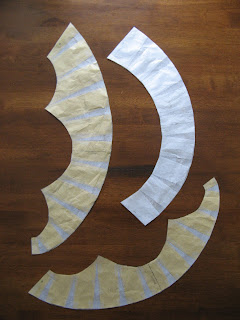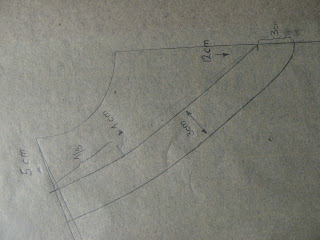Similar to the Challenge 14 top, I will enlarge the arm opening (personal preference) the same amount from the shoulder dart: 2/3 of the dart will be moved into the arm opening; 1/3 will go into the waist to add width (in Challenge 14 1/3 was incorporated into the yoke).
OK, so mark points 1,2, 3 and 4 on the dart and draw a horizontal line from the dart end to the arm opening (point 6), and a vertical one to the hem (point 5). Trace around the pattern from point 1 counterclockwise to point 5. Put a pin in the tip of the dar and rotate the pattern counterclockwise until the right leg of the dart matches point 3 (we just closed 1/3 of the dart and moved it to the waist). Then trace from point 5 (on the pattern) counterclockwise around the pattern to point 6.
Finally, rotate the pattern until the right dart leg matches point 1. Trace around the last part of the pattern - from 6 to 1. Remove the pattern, redraw shoulder seam and the arm opening. I also took another 1 cm down the sideseam to further widen the arm opening.
Extend the length you wish - I added 45 cm from the waist - based on a red tunic I bought last year at Zara. Measure the opening of the dart - in my case this was 2.8 cm. We need this for the top because we will be moving a part of the dart into the waist there as well, and we need to keep the balance between the front and the back, so we need to know how much we added in the back.
Draw in your side seam. Here, I used the Zara tunic again. I really liked how it fit, so why not. Finally, draw in the hipline (about 20 cm below the waistline), if your top extends below the hipline, and make sure that the width is at least H/4 + 4cm, where H is your hip measurement.
The last thing at the back, is to fix the neck opening. See below.
The front will be a little more complicated. We need to draw the neckline, and distribute the dart into the waist and under arm, so we will need to do some tracing as well as cutting, so first, trace your sloper (if you do not wish to modify it).
Neck opening first. It's a square opening, but a deep one, with an insert - it might remind you of a "bib" front? So why not incorporate the dart into the seam of the neck? I tried, but the opening and the insert turned out to be too wide for my taste, too much as a "bib" (not a fan). So I decided to just keep the dart and move it under the arm.
This is how I drew the neck (let's try to keep it simple):
a) open the neck the same as in the back (point 2)
b) measure how deep you want the opening to be (that would be to the top of the insert, point 4)
c) draw a horizontal line from 4 and a vertical line from 2, intersection mark as 5
d) measure how deep you want the insert - in my case it's 10 cm from point 4; draw a horizontal line
e) point 6 lies 2 cm to the right of 5
f)to get the side of the neck opening, draw a line from 2, through 6 down to the bottom of the neck opening.
g) draw the top of the neck opening (the top of the insert) a bit lower at the midpoint (maybe 1.5 mm) - point 9
h) finally, since this is a deep opening, we need to take a bit at the neck, to prevent it from gaping open: point 7 is about 3 cm to the right of 6; 8 is about 0.5 cm to the right of 7. Connect 7 and 8 to the breast point (BP). BP, 7 and 8 make a little "dart" that will be taken in and transferred somewhere else.
Now before we start transferring darts we need to draw in the sideseam. Also mark 1 cm down the sideseam for the arm opening to match the back. Almost forgot - draw another line from BP - down to the hem. Cut the pattern out. Cut out the neck dart we just drew in, also cut out the bust dart and cut along the line from BP down to the hem.
This is the mess you end up with... Close the neck dart and secure with tape. Also tape the midline to the bottom paper, that part of the pattern will not move any more. Draw in where you want the underarm dart to be. Here - 6cm below the arm opening. Cut along this line.
Now comes the fun part - distributing the dart. First of all, leave some at the arm opening - this should match how much we added in the back (forgot to mention this earlier - go back to the back pattern and measure how much you added at the arm opening in the back by moving the shoulder dart). Tape to secure. Then open at the waistline - again match the back. Tape to secure. This will leave you with a dart under arm.
All that's left is to do some fixes... redraw the arm opening - don't forget to take that 1 cm down the sideseam. Redraw the neck opening. Finish the dart.
Add the length, draw the sideseam (below the waistline), draw in the hipline and make sure that you have enough ease there - it should be H/4 + 5 cm at least (H is your hip measurement).
Finally, match the front an the back an the shoulder seam to check the neck and the arm curve.
That's it. Next will be the sleeve.
Previous Challenge 15 posts:
Challenge 15:: Gima tunic:: intro






















































